Apple 15-inch MacBook Pro (Late 2011) Review
by Anand Lal Shimpi on November 17, 2011 5:10 PM EST- Posted in
- Mac
- Apple
- Intel
- MacBook Pro
- Sandy Bridge
- Laptops
The early 2011 MacBook Pro is honestly Apple's best effort to date. Only using quad-core CPUs on the 15 and 17-inch models, and offering an optional Thunderbolt Display that can act as a modern day dock makes this platform, particularly the 15-inch model, the perfect candidate for users who want the power and flexibility of a desktop with the portability of a notebook. Apple gets the mobile revolution in more ways than one, and its MacBook Pro/Thunderbolt Display combo is the perfect example of that.
It's this very combination that I've been using, partially since the introduction of the Sandy Bridge MacBook Pro earlier this year (the Thunderbolt Display didn't arrive until later). I've been quite happy with the setup. With the exception of lackluster Quick Sync adoption by Apple and obviously limited GPU options, I have very few major complaints.
Late last month, Apple updated its 2011 MacBook Pro lineup - likely the first and last update before Apple adopts Ivy Bridge in Q2 next year. We got our hands on the new base 15-inch MacBook Pro configuration, which received one of the more substantial upgrades over the previous model. As this is still a fairly minor upgrade, be sure to read our original review of the platform for a deeper dive into all of the aspects of the system.
| Late 2011 MacBook Pro Lineup | |||||||
| 13-inch (low end) | 13-inch (high end) | 15-inch (low end) | 15-inch (high end) | 17-inch | |||
| Dimensions |
0.95 H x 12.78 W x 8.94 D
|
0.95 H x 14.35 W x 9.82 D
|
0.98 H x 15.47 W x 10.51 D
|
||||
| Weight |
4.5 lbs (2.04 kg)
|
5.6 lbs (2.54 kg)
|
6.6 lbs (2.99 kg)
|
||||
| CPU |
2.4 GHz dual-core Core i5
|
2.8 GHz dual-core Core i7
|
2.2 GHz quad-core Core i7
|
2.4 GHz quad-core Core i7
|
2.4 GHz quad-core Core i7
|
||
| GPU |
Intel HD 3000 Graphics
|
Intel HD 3000 + AMD Radeon HD 6750M (512MB)
|
Intel HD 3000 + AMD Radeon HD 6770M (1GB)
|
Intel HD 3000 + AMD Radeon HD 6770M (1GB)
|
|||
| RAM |
4GB 1333MHz DDR3 (8GB max)
|
||||||
| HDD |
500GB 5400 RPM
|
750GB 5400 RPM
|
500GB 5400 RPM
|
750GB 5400 RPM
|
750GB 5400 RPM
|
||
| Display Resolution |
1280x800
|
1440x900 (1680x1050 optional)
|
1920x1200
|
||||
| Ports |
Gigabit LAN, Firewire 800, Thunderbolt, 2x USB 2.0, SDHC slot, combined audio in/out jack
|
Gigabit LAN, Firewire 800, Thunderbolt, 2x USB 2.0, SDHC slot, separate audio in/out jacks
|
Gigabit LAN, Firewire 800, Thunderbolt, 3x USB 2.0, separate audio in/out jacks, ExpressCard 34 slot
|
||||
| Battery Capacity |
63.5Wh
|
77.5Wh
|
95Wh
|
||||
| Price | $1,199 | $1,499 | $1,799 | $2,199 | $2,499 | ||
Silicon Updates
The focus of Apple's late 2011 update, despite rumors to the contrary, was on the silicon inside the platform. As the Mac business is a relatively mature one, we can expect a slower pace of chassis and design upgrades compared to the iPhone/iPad businesses for example.
We'll start with the CPU, the lesser updated chip in the new MacBook Pro. System pricing hasn't changed, but CPU speeds have all gone up.
Just as before the 15-inch MacBook Pro is only available with a quad-core Intel Core i7 CPU (codename Sandy Bridge). The $1799 configuration goes from a 2.0GHz i7 to a 2.2GHz model. Be warned, this isn't the same 2.2GHz model that was available as an upgrade earlier this year though.
A quick run of Cinebench points out that the 2.2GHz i7 in our system may be a Core i7 2675QM. The original 2.2GHz option was a Core i7 2720QM. What's the difference between the two? Not a whole lot.

Max turbo is down a bit on the 2675QM. It was 3.3GHz on the 2720, but now it's 3.1GHz. The two, three and four core turbo limits are also down by 200MHz compared to what they were in early 2011. If you didn't have a 2.2GHz early 2011 15-inch MacBook Pro, these differences likely don't mean anything. If for whatever reason you're comparing to an early 2011 2.2GHz model, you'll see a slight regression in CPU bound performance.
The on-die GPU is a hair slower as well. You still get an Intel HD 3000 GPU (12 EUs) but the max turbo moves from 1.3GHz down to 1.2GHz. Or if you prefer another way of looking at it, the 2675QM is the same as the 2670QM, except the GPU is able to clock 100MHz higher (1.2GHz vs. 1.1GHz).
| Apple 15-inch Late 2011 MacBook Pro CPU Comparison | |||||
| 2.2GHz quad-core | 2.4GHz quad-core | 2.5GHz quad-core | |||
| Intel Model | Core i7-2675QM | Intel Core i7-2760QM | Intel Core i7-2860QM | ||
| Base Clock Speed | 2.2GHz | 2.4GHz | 2.4GHz | ||
| Max SC Turbo | 3.1GHz | 3.5GHz | 3.6GHz | ||
| Max DC Turbo | 3.0GHz | 3.4GHz | 3.5GHz | ||
| Max QC Turbo | 2.8GHz | 3.2GHz | 3.3GHz | ||
| L3 Cache | 6MB | 6MB | 8MB | ||
| AES-NI | Yes | Yes | Yes | ||
| VT-x | Yes | Yes | Yes | ||
| VT-d | No | Yes | Yes | ||
| TDP | 45W | 45W | 45W | ||
The upgraded 15-inch configuration comes with an all new Sandy Bridge SKU: the Core i7 2760QM running at 2.4GHz. Unlike the old 2.3GHz part, the 2760QM still only has a 6MB L3 cache. You do get higher base and turbo speeds. There's also a new 2.5GHz quad-core option that can run at up to 3.6GHz with a single core active. That's an absolutely insane frequency for a notebook. Notebook-as-a-desktop users will appreciate the flexibility here.
All of the new CPUs support AES-NI, although once again Apple is the victim of Intel's silly segmentation. The entry level 2.2GHz part does not support VT-d (Virtualization Technology for Directed I/O), which allows virtual machines to have direct access to I/O devices (including PCIe GPUs). I'm not sure if any current virtualization software for OS X supports VT-d, but the absence of the feature is important to note nonetheless. The rest of the CPU lineup supports VT-d.

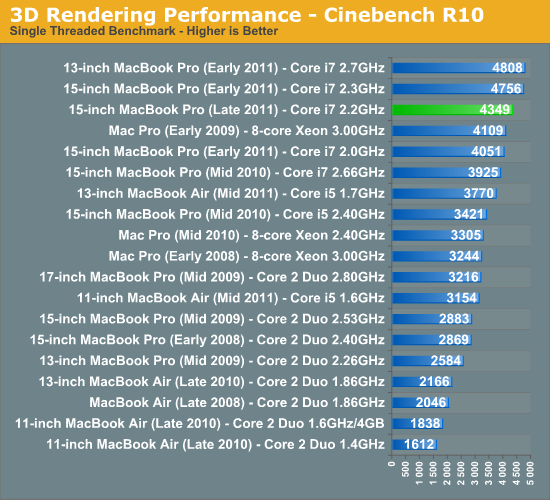
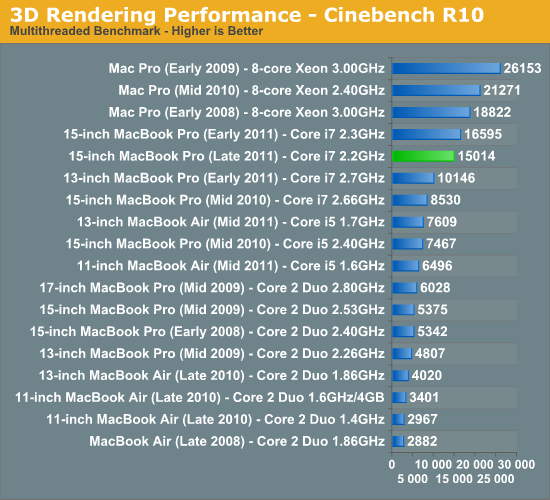
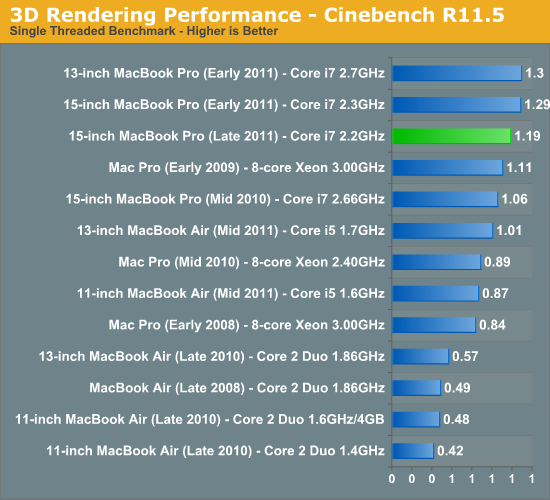
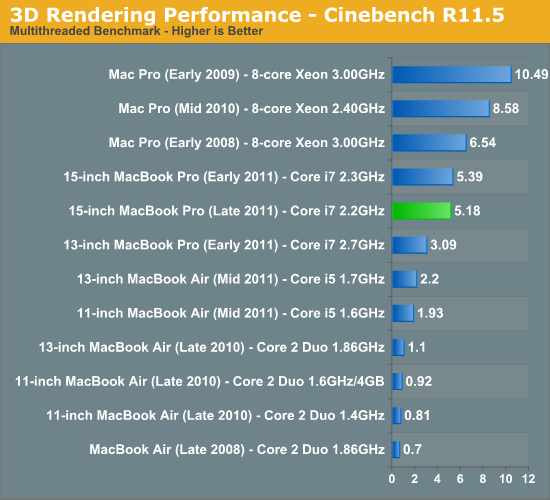
Battery Life
TDPs haven't changed, nor has the MacBook Pro's battery capacity, so overall battery life should (and does) remain relatively unchanged from the early 2011 models. Worst case scenario you can expect around 2.5 hours of battery life under load. With moderate load expect 4 - 5 hours of use on a single charge. And under a very light load you can easily exceed 7 hours.
I ran our normal battery life suite, however Lion has made some of the numbers a little less comparable than I would've liked. The lighter use cases (e.g. our web browsing tests) see a drop compared to our older Snow Leopard results. Under full load the new platform, even while running Lion, actually did a bit better than its predecessor. All in all I'd say the new MacBook Pro is pretty consistent with its predecessor - Lion just threw a wrench in a lot of our battery life comparisons so we'll be starting over from scratch in building our new database.
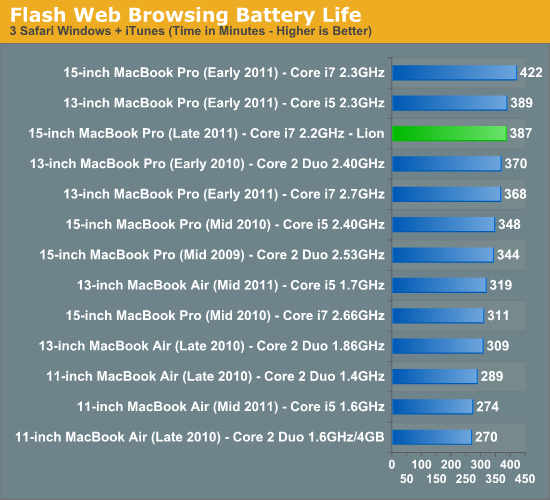
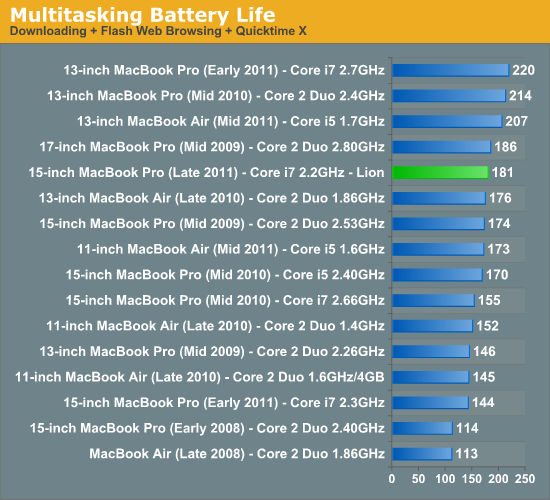


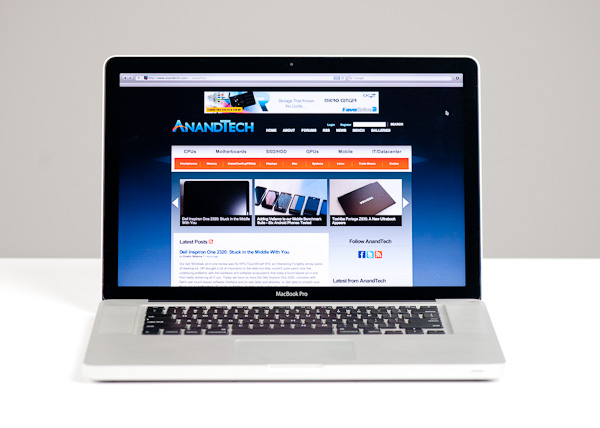
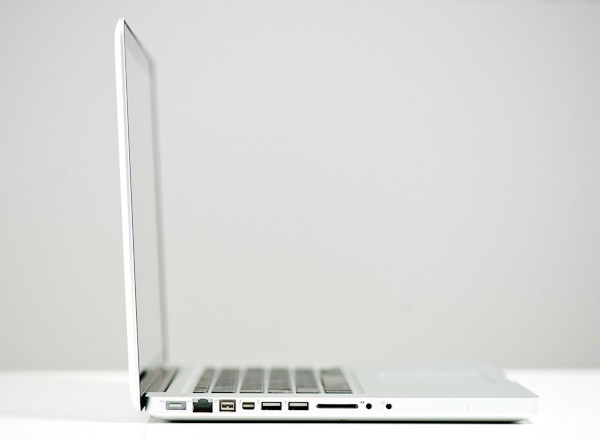
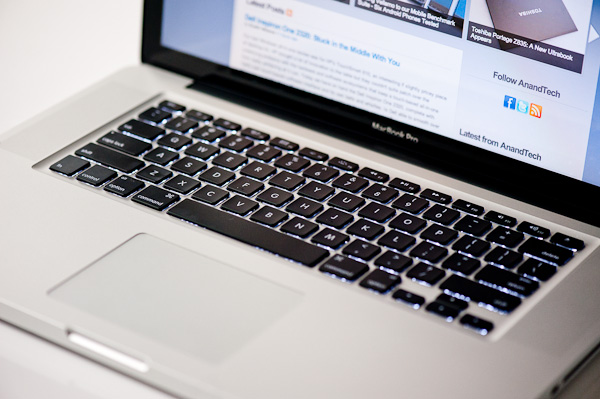








101 Comments
View All Comments
futurepastnow - Friday, November 18, 2011 - link
And 5400 RPM hard drives standard. Now that's a bad joke.It's also pretty sad that the 13" model still has a 1280x800 screen when Apple's own 13" Macbook air uses a 1440x900 display.
trifecta88 - Friday, November 18, 2011 - link
It could be because current benchmarks are being done on Lion and not Snow Leopardgrahamnp - Friday, November 18, 2011 - link
The 2.2 tested is the replacement for the old 2.0ghz which isn't shown in all the charts but when compared it does come out on top.name99 - Saturday, November 19, 2011 - link
You do realize that the 2.3 GHz model (early 2011) was the EXTREME HIGH END model (best of 2.0, 2.2 and 2.3GHz);the 2.2 GHz model (late 2011) is the LOW END model (worst of 2.2, 2.4 and 25)?
The article could do a better job of explaining that, I'll admit. But you (and even worse, some of the idiotitic followup commentators) could do a better job of not assuming something that is highly unlikely --- that Apple has DELIBERATELY chosen to reduce the performance of its machines, and that Anand is so in love with them that he thought this wasn't worth mentioning.
Better commenters, please.
loox - Sunday, November 20, 2011 - link
Wow... an off-topic, major PC vs Mac fanboy flame war on an Anandtech article re: an Apple product. That *never* happens. *yawn* They both have their place on this planet. Moving on...I'd like to remain on topic *gasp!* and return to the OP's observation:
I am confused, as well... is this a typo in the charts? or is my 15" early 2011 macbook pro really superior to the late 2011 in benchmarks... this is not making sense to me.
On the flipside, if true, it makes me very happy as I purchased the macbook pro for the video card, and am happy to see that I would not have lost much performance gain had I waited for the later 2011 model.
loox - Sunday, November 20, 2011 - link
I am seeing what I think may be the cause...In "early 2011" I purchased the higher end 15" Macbook Pro. At that time, the more expensive model came with the Radeon 6750 and a slightly higher clocked Core i7 SandyBridge (2.3 Ghz). It looks like this model was used in the charts above.
Meanwhile, the model that Anandtech benchmarks in *this* review, is the lower end (cheaper) 15" Macbook Pro which, in "late 2011" has the (1) the same Radeon 6750 GPU as the higher-end, early 2011 Model I have and (2) a slightly slower clocked Core i7 SB CPU (2.2 Ghz).
This explains alot.... had Anandtech tested the 2200 USD variant of the "late 2011" 15" MBP, it surely would have bested my 2200 USD variant of the "early 2011" 15" MBP because it would have benchmarked the higher-end Radeon 6770 and CPU in the 2200 USD MBP.
Basically, it looks like the hardware in my 2200 dollar MBP from early 2011 is now comparable to the hardware in the "late 2011"'s 1800 dollar MBP As a result, I would have waited 2 months had I known I could get pretty much the same hardware for 400 dollars less. But, hindsight is 20/20 and something better always comes along.
This does, however, explain the benchmark tables in this article. Had the higher end variant of the late 2011 MBP been used, the results would no doubt have favored the newer model.
ThreeDee912 - Monday, November 21, 2011 - link
After seeing those charts I knew someone was read it incorrectly and assume Apple is gimping their systems or something....The Early 2011 model is the *high-end* 15" upgraded to the optional built-to-order 2.3 GHz (2820QM) i7 with 8MB L3 cache.
It still ranks slightly higher than the newer model, because the new Late 2011 model in the charts is only the *low-end* stock 15" model with a 2.2 GHz (2675QM) i7 6MB L3 cache.
So the low-end 15" model is quite a bit faster than before, but still not as fast as the highest-end customized 15" model from a few months ago.
To exaggerate, it's like saying "Why is my old i7 still faster than this new Pentium?"
You can see the previous specs here in a neat chart here:
http://en.wikipedia.org/wiki/MacBook_Pro#Technical...
TheGeoff - Thursday, November 17, 2011 - link
It's been awhile since I've gotten to spend any time with this body style. Do they still have that sharp "wrist-cutter" edge on the front? That was a deal killer for me.Brian Klug - Thursday, November 17, 2011 - link
This is actually one of the more subtle things I've noticed with the newer MBPs.After MacBookPro6,2 the front edge on every MBP has received a very small bevel that makes a huge difference on the wrists. I have an 8,2 which has the bevel, so anything newer than 6,2 should likewise have it. It makes the difference between wrist-cutting and not right at the center thumb-notch area too (which used to come to a very sharp point on both sides).
-Brian
retrospooty - Thursday, November 17, 2011 - link
a 15 inch laptop with 1440x900 LCD, 2.2ghz quad core 4gb ram for $1800. I could literally get 2 equivalent ones for that price